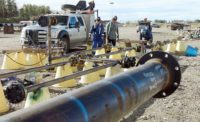 Conirsa Peruvian child tries a new toothbrush. |
MAZUCO, Peru - The 700 kilometers of the Interoceanic Highway Conirsa is constructing cross some of the most remote regions of Southern Peru.
The existing dirt-packed highway allows only limited access to the regions of mountains and the jungle that the road cuts through and none at all during the four-to-six-month rainy season. The road is impassable then.
The people that live in the small communities along the route are looking for the new all-weather roadway to improve their standard of living - one of the worst in the country. Conirsa has inaugurated a traveling social outreach program to help during highway construction.
"When you construct highways you change the entire world for the people who live along it," said Marcus Felipe, director of Conirsa's Tramo III project in the Peruvian jungle. "There is a responsibility to help them handle the changes a road like this will bring."
 Conirsa Government hopes InterOceanic Highway will raise standard of living in remote villages. |
Conirsa has invested $2 million in the Traveling Support Program for Health and Education, known by its Spanish-language acronym, PASE. The program organizes efforts of the regional and national government, particularly the regional department of health.
"We are not experts on social programs but we are very very good at logistics," explained Gonzalo Bussalleu, who is in charge of the program.
The program is slated to run through the extent of the construction - about three years - but Conirsa hopes the consortium or the public agencies find ways to keep it going in some form, he said.
The initial idea was to help the local communities prepare for the influx of tourism that will be possible due to the roadway. That was put aside after visits to the communities showed that most needed much more basic levels of assistance, Bussalleu said.
 Conirsa Local police teach classes in traffic safety. |
Many of these communities endure the most severe poverty in the country. According to the World Bank, three-quarters of rural residents live below the national poverty line and a full 40 percent are in extreme poverty - including the 5.5 million Peruvians who survive on less than $1 a day.
The first challenge for the program was identifying what program would do the most to benefit the communities. Eventually, providers selected dental care, because very few people in the area ever received any type of education on the subject, much less professional attention.
Dentistry is a specialized field requiring a great deal of cumbersome, and expensive, equipment. Regular doctors can carry medicines, but will not likely be many dentists working where there isn't a dental chair within hundreds of kilometers, Bussalleu said.
There was also another very compelling reason to start with a dentisit, he explained.
"And, when we asked people, this was one of the things they wanted to see most," he said.
So Conirsa obtained a truck and outfitted it with dental equipment. The vehicle travels the length of the company section of the Interoceanic Highway project stopping at every community to provide dental care.
The first month-long effort was in May and the second will take place this month. Future versions of the program may include other specialized medical assistance such as an obstetrician or an optometrist, Bussalleu said.
Each stop usually last a week and involves a series of workshops and programs for the entire community that are presented by the 22-person team made up of medical personnel, social work professionals, teachers and law enforcement experts. They teach a battery of topics, including: sanitation, health and preventive medicine.
Schoolchildren learn the basics and are presented with free toothbrushes. Adults attend classes on better health through balanced diet.
The workshops also offer an opportunity for Conirsa to prepare the communities for the dangers of living near a large modern highway. The PASE team includes several Peruvian traffic officers who explain the basics of highway safety to both the children and the adults who will live in the communities near the road.
"We have to educate them about the dangers the highway will present and how they can safely live near it and use it themselves," Bussalleu said.
The road is an important part of the communities -- pedestrians, bicycles riders and small herds of livestock are common.
For the most part, the existing dirt road capped the maximum speed on the road at no more than 60 miles per hour and that only on short stretches. With the new road, that speed will be possible across almost the entire length of the highway.
"This road is going to change everything here in a dramatic way," Bussalleau said. "We are trying to give the people what they need to be ready to handle that change."


